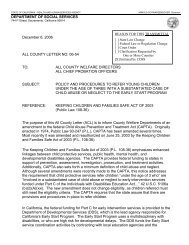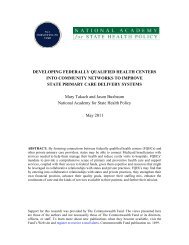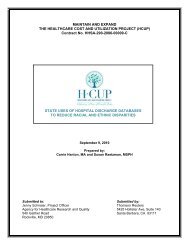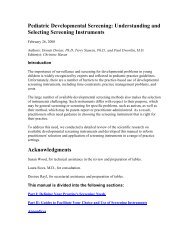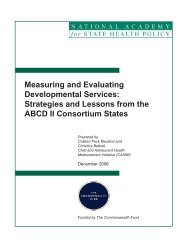Improving Care Coordination, Case Management, and Linkages to
Improving Care Coordination, Case Management, and Linkages to
Improving Care Coordination, Case Management, and Linkages to
You also want an ePaper? Increase the reach of your titles
YUMPU automatically turns print PDFs into web optimized ePapers that Google loves.
tA b l e 3: li n kAg e A n d cc/cm st rAt e g i e s <strong>to</strong> P r o m o t e c o o r d i nAt i o n between m e d i cA l P rov i d e r s A n d<br />
c o m m u n i t y r e F e r rA l A n d r e s o u r c e Agencies<br />
20<br />
Primary care practicebased<br />
strategies<br />
Service provider linkage strategies<br />
Systems change <strong>and</strong> crosssystem<br />
strategies<br />
Role of State Fis- Strategies that transform the Strategies that strengthen relationships Strategies that enhance or transcal<br />
<strong>and</strong> Adminis- way pediatric primary care between pediatric primary care <strong>and</strong> form operations between health<br />
trative Support practices are organized <strong>to</strong> other providers<br />
<strong>and</strong> other service systems at state<br />
deliver care<br />
level<br />
Support for Medical homes that use Community-based staff that assist <strong>Care</strong> coordination utilities<br />
strategies that care planning <strong>and</strong> care providers <strong>and</strong> families in complet- that operate across a state<br />
maximize use of coordination approaches. ing referrals <strong>and</strong> linkages.<br />
(e.g., EPSDT coordina<strong>to</strong>rs<br />
personnel in link-<br />
statewide, coordination<br />
ages <strong>and</strong> CC/CM Staff assigned <strong>to</strong> assure Co-location of primary health care networks.<br />
referrals <strong>and</strong> linkages,<br />
including onsite care coordina<strong>to</strong>rs.<br />
<strong>and</strong> other service providers (e.g.,<br />
child development, social work,<br />
mental health).<br />
New structures <strong>to</strong> organize<br />
CC/CM personnel <strong>and</strong><br />
programs (e.g., public health<br />
Resource <strong>and</strong> referral strategies <strong>to</strong><br />
help medical providers <strong>and</strong> families<br />
learn about/link <strong>to</strong> resources,<br />
nurses, community social<br />
workers, MCO staff, CSHCN<br />
coordina<strong>to</strong>rs).<br />
including parent-<strong>to</strong>-parent ap- Health <strong>and</strong> mental health<br />
proaches.<br />
consultants in early care <strong>and</strong><br />
education programs who<br />
provide referral <strong>and</strong> linkages<br />
<strong>to</strong> other providers.<br />
Support for qual- Quality improvement Quality improvement initiatives Shared or common st<strong>and</strong>ards,<br />
ity improvement efforts within clinical that engage networks of provid- definitions, <strong>and</strong> pro<strong>to</strong>cols<br />
initiatives <strong>and</strong> practice settings which can ers in measuring <strong>and</strong> changing across systems (e.g., com-<br />
other mecha- address gaps in knowledge performance.<br />
mon referral forms, shared<br />
nisms for assuring<br />
<strong>and</strong> moni<strong>to</strong>ring<br />
quality<br />
<strong>and</strong> behavior (e.g., introduce<br />
new <strong>to</strong>ols, quality<br />
measurement).<br />
Moni<strong>to</strong>r <strong>and</strong> provide incentives<br />
for quality of care coordination,<br />
including completion of referrals, <br />
definitions of special needs or<br />
special risks).<br />
Public-private payer quality<br />
care plans, etc.<br />
initiatives.<br />
Cross-system professional<br />
training.<br />
Support for data, Adoption of technology Data, information, <strong>and</strong> technology Macro data <strong>and</strong> informainformation,<br />
such as electronic medical strategies that support linkages tion strategies (e.g., surveys,<br />
<strong>and</strong> technology records that facilitate link- (e.g., common referral forms, tele- early childhood information<br />
that facilitates ages <strong>and</strong> CC/CM<br />
phone consultation, telemedicine). systems, shared resource data<br />
linkages <strong>and</strong><br />
communication<br />
among families<br />
<strong>and</strong> providers<br />
Practice-based follow-up<br />
systems (e.g., practice registries,<br />
tracking systems).<br />
Electronic medical/health records<br />
that support patient-centered<br />
care.<br />
<br />
bases) that guide planning for<br />
early childhood health <strong>and</strong><br />
related services.<br />
Strategies <strong>to</strong> reduce administrative<br />
barriers for sharing<br />
information.<br />
Support for in- Individualized care plans <strong>Care</strong> plans that incorporate Planning for improved integradividualized<br />
care used by primary care pro- multiple provider perspectives <strong>and</strong> tion of early childhood servic-<br />
plans <strong>and</strong> crossviders/medical homes. recommendations.<br />
es <strong>and</strong> systems with support<br />
systems planning<br />
Part C Individualized Family<br />
Service Plans (IFSP) that link <strong>to</strong><br />
pediatric primary care providers.<br />
for local implementation (e.g.,<br />
early childhood comprehensive<br />
systems initiatives).<br />
<strong>Improving</strong> <strong>Care</strong> <strong>Coordination</strong>, <strong>Case</strong> <strong>Management</strong>, <strong>and</strong> <strong>Linkages</strong> <strong>to</strong> Service for Young Children: Opportunities for States<br />
National Academy for State Health Policy



